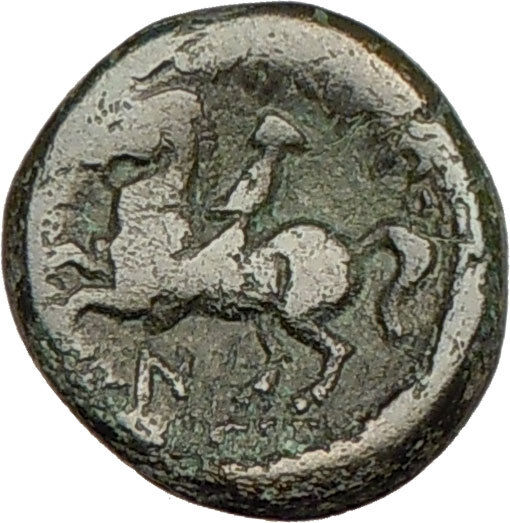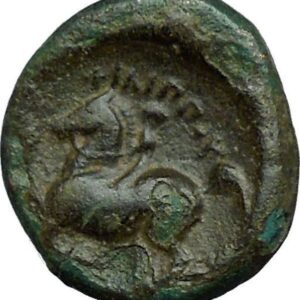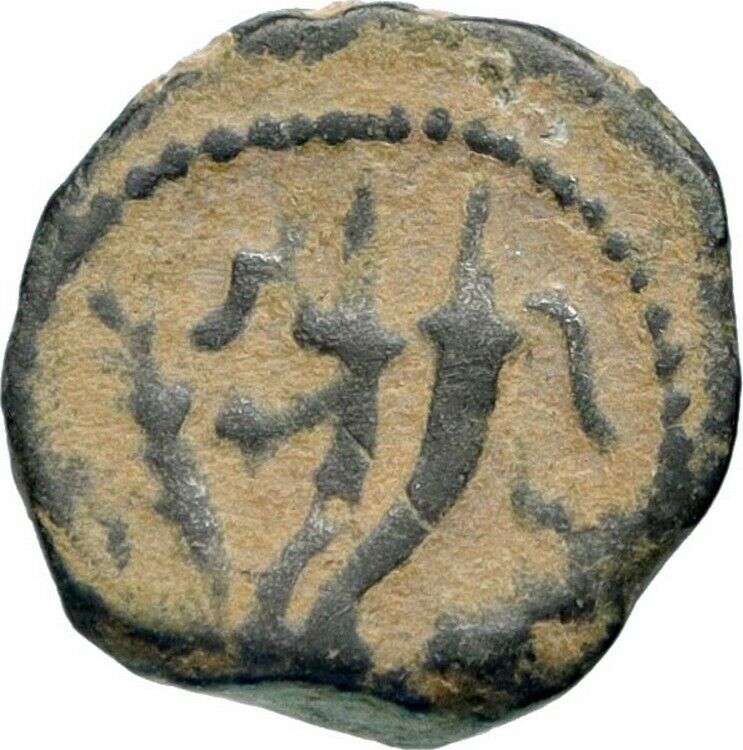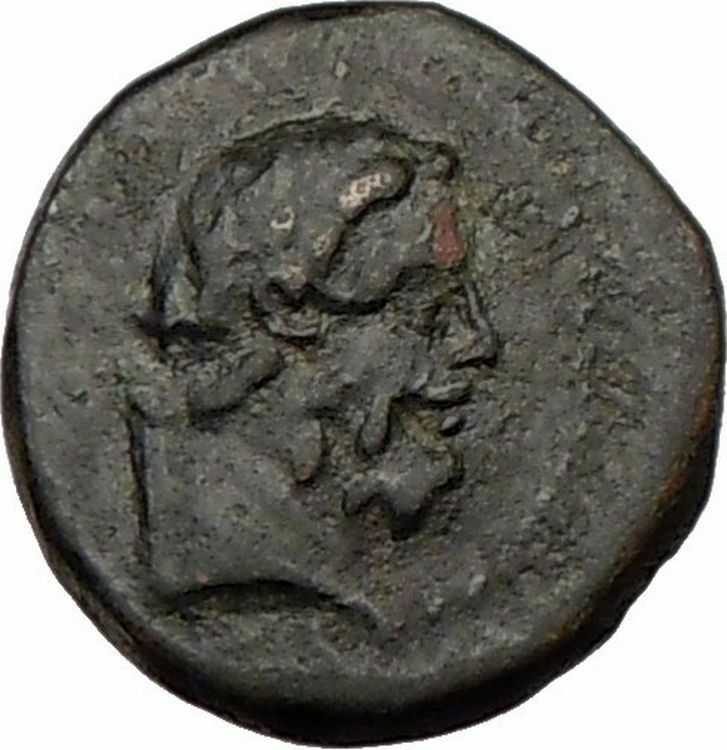|
Greek city of
Gargara
in
Troas
Bronze 8mm (0.61 grams) Struck circa 350 B.C.
Reference: Sear 4090 var.; SNG Ashmolean 1136 var. (grapes below horse); SNG
Copenhagen 326–9
Laureate head of
Apollo
right.
ΓAΡ above
h
orse
galloping right.
On the Gulf of Adramytteion, between Antandros and Assos, the
territory of Gargara was famed for the fertility of its soil.
You are bidding on the exact item pictured,
provided with a Certificate of Authenticity and Lifetime Guarantee of
Authenticity.

In
Greek
and
Roman mythology
,
Apollo,
is one of the most important and diverse of the
Olympian deities
kouros
(a beardless youth), Apollo has been
variously recognized as a god of light and the sun; truth and prophecy;
archery
; medicine and healing; music, poetry,
and the arts; and more. Apollo is the son of
Zeus and Leto
, and has a
twin
sister, the chaste huntress
Artemis
. Apollo is known in Greek-influenced
Etruscan mythology
as Apulu. Apollo was
worshiped in both
ancient Greek
and
Roman religion
, as well as in the modern
Greco
–Roman
Neopaganism
.
As the patron of Delphi
(Pythian Apollo), Apollo was an
oracular
god — the prophetic deity of the
Delphic Oracle
. Medicine and healing were
associated with Apollo, whether through the god himself or mediated through his
son Asclepius
, yet Apollo was also seen as a god
who could bring ill-health and deadly
plague
as well as one who had the ability to
cure. Amongst the god’s custodial charges, Apollo became associated with
dominion over
colonists
, and as the patron defender of herds
and flocks. As the leader of the
Muses (Apollon Musagetes) and director of their choir, Apollo
functioned as the patron god of music and
poetry
.
Hermes
created the
lyre for him, and the instrument became a common
attribute
of Apollo. Hymns sung to Apollo were
called paeans
.
In Hellenistic times, especially during the third century BCE, as Apollo
Helios he became identified among Greeks with
Helios
,
god of the sun
, and his sister Artemis
similarly equated with
Selene
,
goddess of the moon
. In Latin texts, on the
other hand, Joseph Fontenrose declared himself unable to find any conflation of
Apollo with
Sol
among the
Augustan poets
of the first century, not even
in the conjurations of
Aeneas
and
Latinus
in
Aeneid
XII (161–215). Apollo and Helios/Sol
remained separate beings in literary and mythological texts until the third
century CE..
Gargara was a
Greek
city on the southern coast of the
Troad
region of
Anatolia
. It was initially located beneath
Mount Gargaron, one of the three peaks of
Mount Ida
, today known as Koca Kaya At
some point in the 4th century BCE the settlement moved approximately 5.8 km
south of Koca Kaya to a site on the small coastal plain near the modern villages
of
Arıklı
and
Nusratlı
, at which point the previous site came
to be known as Old Gargara (Ancient
Greek Παλαιγάργαρος).
Both sites are located in the
Ayvacık
district of
Çanakkale Province
in
Turkey
.
Mount Gargaron
Mount Gargaron has been identified with the mountain today called Koca Kaya (Turkish
Great Rock), a western spur of Mount Ida with a maximum elevation of 780
m. The poet
Epicharmus
(fl. 540 – 450 BCE) refers to
the mountain as “snowcapped” (ἀγάννιφα), and the
Etymologicum Magnum
(ca. 1150 CE) knew a
tradition according to which the inhabitants of Old Gargara moved to their new
site to escape the cold of their old home. In
Homer’s
Iliad
it is said to have had an altar to
Zeus at its summit, and hence is a place the god frequently visits.
In one passage Zeus is said to have come to Mount Gargaron from
Mount Olympos
to view the battle between the
Trojans and the
Acahaeans
, about 50 km NE of here. In writers
of the 1st and 2nd century AD such as
Statius
and
Lucian
Zeus is said to have abducted the Trojan
prince
Ganymede
from Mount Gargaron while he was
hunting in the nearby forests. Lucian also represents the
Judgement of Paris
as taking place on Mount
Gargaron rather than in its more traditional location further to the east above
Antandrus
. The anonymous author of On Rivers
thought that Gargara was Mount Ida’s previous name, while the Latin poet
Valerius Flaccus
used it as a learned way of
referring to Ida. The Etymologicum Magnum explains the name of Gargaron
either as deriving from the verb γαργαρίζειν (‘to gargle’) on account of the
springs thought to bubble up on the summit (an inference taken from Homer’s
reference to ‘many-fountained Ida’ in conjunction with Gargaron), or as deriving
from γαργαρέων (‘uvulaa‘)
on account of the mountain’s shape.
The poet Aratus
of
Soli
wrote an epigram about his friend Diotimos,
who used to teach the children of Gargara their letters up on Mount Gargaron:
-
-
- αἰάζω Διότιμον, ὃς ἐν πέτρῃσι κάθηται
- παισὶν Γαργαρέων βῆτα καὶ ἄλφα λέγων.
-
-
- I bewail Diotimos, who would sit among the rocks
- Teaching the children of the Gargarians their alpha and beta.
History
Foundation
There is no indication in the relevant passages of the Iliad that
Homer considered Mount Gargaron inhabited. This is partly confirmed by the fact
that the earliest archaeological remains found at the site (fortification walls
around the acropolis and the foundations of a temple) date no later than the 6th
century BCE. In the 7th century BCE the poet
Alcman
said that the settlement was inhabited
by Leleges
, an Anatolian people, but this may
simply be an inference from Homer’s remark elsewhere in the Iliad that
the whole southern coast of the Troad was inhabited by Leleges.[14]
Hecataeus of Miletus
(ca. 550 – 476 BCE) and
Hellanicus of Mytilene
(ca. 490 – 405 BCE) say
that Gargara was inhabited by
Aeolian
Greeks originally from nearby
Assos
and Myrsilos of
Methymna
(first half of the 3rd century BCE)
that Assos was a foundation of Methymna, hence the Aeolian ethnicity of Assos
and the secondary foundations of Gargara and
Lamponeia
. If Alcman was correct to indicate
the existence of an Anatolian settlement named Gargara in the 7th century BCE,
then this fact could be harmonized with the apparently contradictory story of
Gargara instead being a Greek foundation by noting that many settlements in this
region had a mixed Greco-Anatolian heritage in which the local Anatolian
population became assimilated with the Greek newcomers. With respect to how the
early settlement came to adopt the name of the mountain, John Cook, the
archaeologist who identified the site of Old Gargara on Koca Kaya, remarked
that: “What we can believe is that the people of Methymna across the strait
pointed to this bold peak as the Homeric Γάργαρον ἄκρον and that the settlers
there felt themselves entitled to appropriate the name”.
Classical
In the 5th century BCE Gargara was a member of the
Delian League
and paid a tribute to Athens of
between 4,500 and 4,600
drachmas
as part of the Hellespontine district.
It is currently thought that the Gargarians moved from the site at Koca Kaya
down to the coast in the 4th century BCE, although this has not been confirmed
by excavation. A long inscription found at
Ilion
indicates that by ca. 306 Gargara was a
member of the koinon
of Athena Ilias, a regional
association of cities in the Troad which held an annual festival at Ilion. The
inscription records a series of honorific decrees passed by the koinon
which praise a prominent and wealthy citizen, Malousios of Gargara, for
providing interest free loans to finance the annual festival.
Hellenistic
The local antiquarian writer
Demetrius of Scepsis
(ca. 205-130 BCE) relates
that Gargara received an influx of settlers who were forcibly moved their home
in Mysia
,
Miletoupolis
, by ‘the kings’ (presumably those
of
Bithynia
) in the late 3rd or early 2nd century
BCE. Miletoupolis was a semi-Greek settlement, and so Demetrius relates that as
a result of this influx of immigrants there are hardly any Aeolians left in
Gargara. This episode should perhaps be connection with the invasion of this
region by
Prusias II of Bithynia
in 156 – 154 BCE.
Elsewhere in the Hellenistic period, citizens of Gargara are found serving as
proxenoi
at
Chios
and as mercenaries at
Athens
, participating in a private association
of resident foreigners on
Rhodes
, making dedications to
Ptolemy III Euergetes
and his family in Egypt,
receiving honours at Ilion, and making dedications on
Delos
. In the 230s or 220s BCE Gargara was one
of the places at which
Theorodokoi
of
Delphi
were received, and in the 120s BCE it is
attested as a port at which customs dues was being paid soon after
Attalus III
had bequeathed the
Asia
to Rome in 133 BCE.
Roman
While Gargara continued to exist in the Roman period, we hear about it
primarily in the context of Latin literature, since it became a by-word for
agricultural prosperity in Latin poetry following
Virgil’s
reference to it in the
Georgics
:
-
-
- humida solstitia atque hiemes orate serenas,
- agricolae; hiberno laetissima pulvere farra,
- laetus ager: nullo tantum se Mysia cultu
- iactat et ipsa suas mirantur Gargara messis.
-
-
- Pray for wet summer, farmers, and for clear skies in winter
- (since after winter dust most joyous is the corn and joyous the
- fields); never else than after such seasons does
Mysia
take such
- pride in its tillage, and Gargara itself marvel so at its
harvests.
Gargara is likewise used as an expression of proverbial fertility in
Ovid’s
Ars Amatoria
,
Seneca’s
tragedy The Phoenician Women,
and as late as the 5th century CE in the odes of
Sidonius Apollinaris
.
Macrobius
in his
Saturnalia
(early 5th century CE) devoted a
chapter to the question of what had given Virgil the idea of using Gargara this
way in the first place, concluding that it was an inference firstly from Mount
Ida’s reputation for being well-watered in Homer, secondly from Mysia’s general
reputation for fertility, and thirdly from the use of γάργαρα (gargara)
in
Old Comedy
to express an immense quantity of
anything.
Byzantine
Gargara appears to have been continuously occupied until at least the 9th
century CE, and perhaps as late as the 14th century CE. It was a
suffragan bishopric
of the
metropolis
of
Ephesus
for which we know the names of three of
its bishops: John (518 CE), Theodorus (553 CE), and Ephraim (878 CE). In
addition to possible middle Byzantine remains seen at Gargara by John Cook,
other documents such as the Epistulae Dogmaticae of
Patriarch Germanus I of Constantinople
(715-730
CE) and the
Notitiae Episcopatuum
also attest Gargara’s
continued existence throughout this period. Finally, four documents from the
Monastery of Great Lavra
on
Mount Athos
dating to 1284 and 1304 CE attest a
Constantine of Gargara and his family. The latest period of occupation at the
site may be represented by the nearby castles of Menteşe and Şahin Kale which
Cook thought could be either Byzantine or
Genoese
.
|









